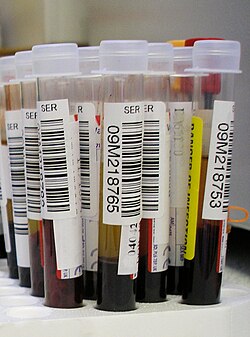Portfolio:The Comprehensive Guide to Physician Office Laboratory Setup and Operation
Title: The Comprehensive Guide to Physician Office Laboratory Setup and Operation
Edition: Second edition
Author for citation: Shawn E. Douglas
License for content: Creative Commons Attribution-ShareAlike 4.0 International
Publication date: June 2022
This guide provides an in-depth discussion of the physician office laboratory (POL) and its place in the clinical laboratory world. Though a lot has changed in regards to the POL and the role it plays in clinical testing—including a pandemic—the POL remains an important part of the clinical testing culture today and deserves discussion. This guides discusses that clinical environment, as well as the testing domains typical to the POL, the data management considerations it must make, and the regulatory and quality assurance issues that come with the territory. Also included are a great many useful, POL-friendly resources like CLIA-waived test vendors, education programs for laboratorians, and more.
This second edition, among other things, updates numerous statistics, adds new findings related to POLs, and reorganizes the structure to be more consistent with current LIMSwiki guides. Trends concerning reimbursement for tests, molecular testing, pharmacy labs, and more were added to the guide, as was more up-to-date information about return on investment, data management practices, and quality assurance. All reference resources in the guide were also refreshed for this update to show the latest education programs, CLIA-waived offerings, and more.
NOTE: This was originally published on LIMSwiki.org and is reproduced here using the same license.
The table of contents for The Comprehensive Guide to Physician Office Laboratory Setup and Operation is as follows:
- 1.1 The POL as a clinical laboratory
- 1.2 Good laboratory practices
- 1.3 Laboratory safety
- 1.4 Regulatory compliance: HIPAA and PPACA
- 1.5 Regulatory compliance: CLIA
- 1.6 Point-of-care testing
- 1.7 Provider-performed microscopy testing
- 1.8 CLIA market and industry trends
- 1.8.1 Clinical laboratory testing trends
- 1.8.2 POL testing trends
- 1.8.3 Addition of the Dual 510(k) and CLIA Waiver by Application process
- 1.8.4 More sophisticated CLIA-waived tests appear
- 1.8.5 Other players in the CLIA market
- 1.9 Economic issues related to the POL
- 1.10 Data management
- 1.10.1 Data management tools and challenges
2. Primary laboratory testing domains in the POL
- 2.1 Urinalysis
- 2.1.1 Basic concepts and collection procedures
- 2.1.2 Urine composition
- 2.1.3 Testing
- 2.2 Hematology and blood collection
- 2.2.1 Basic concepts and collection procedures
- 2.2.2 Blood composition
- 2.2.3 Testing
- 2.3 Clinical chemistry
- 2.3.1 Basic concepts and collection procedures
- 2.3.2 Fluid composition
- 2.3.3. Testing
- 2.4 Immunology
- 2.4.1 Basic concepts and collection procedures
- 2.4.2 Specimen composition and testing
- 2.5 Toxicology and pain management
- 2.5.1 Testing
- 2.6 Molecular diagnostics
- 3.1 Workflow and functional requirements
- 3.2. LIS integration with software and instruments
- 3.2.1 EHR-LIS integration and interfacing
- 3.3 Best practices and standard operating procedures
- 3.4 Other workflow requirements
4. Education, staffing, accreditation, and other considerations
- 4.1 Education and training
- 4.2 Educational programs
- 4.2.1 Higher-education
- 4.2.2 One-year hospital-based programs
- 4.2.3 Continuing education
- 4.3 Certification and accreditation
- 4.3.1 Individual certification and accreditation programs
- 4.3.2 Laboratory accreditation programs
- 4.4 Other considerations for the POL
5. Final thoughts and additional resources
- 5.1 Final thoughts
- 5.2 Further reading
- 5.3 CLIA-waived instrument and test kit vendors
- 5.4 Other diagnostic instrument and test kit vendors
- 5.5 Instrument and equipment distributors
- 5.6 Consultants serving the POL market
- 5.7 Consumables and supplies used in the POL
- 5.7.1 Diagnostic analyzers and devices (CLIA-waived)
- 5.7.2 Diagnostic test kits and supplies (CLIA-waived)
- 5.7.3 Laboratory furniture and equipment
- 5.7.4 Medical supplies
- 5.8 Staffing agencies
- 5.8.1 National (U.S.) and global
- 5.8.2 Regional (U.S.)
- 5.9 Laboratory billing and revenue enhancement
